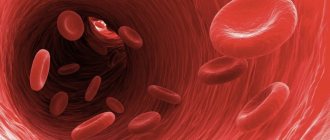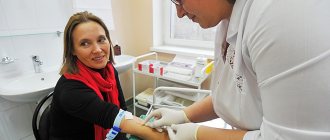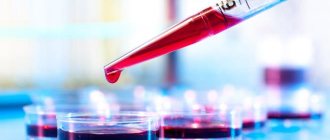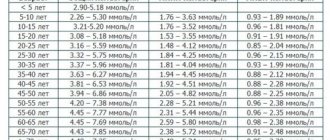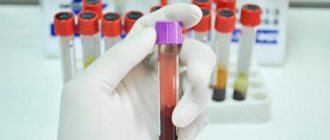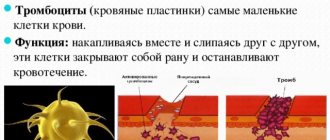Bilirubin is the result of the breakdown of a complex blood protein - hemoglobin. This colored pigment appears during the hemolysis of erythrocytes, red blood cells that are renewed in the human body every 110 days.
Direct and indirect bilirubin are substances formed as a result of this breakdown; they arise in the bone marrow, are present in fairly large quantities in the spleen, bile, and are excreted from the body by the liver, in the form of urine, or through feces.
Attention! Indirect bilirubin is a substance toxic to the body, a transition product of the breakdown of red blood cells.
This pigment cannot dissolve on its own in water. In order for it to be removed from the human body, reactions must occur in the liver, as a result of which it will take a soluble form and turn into direct bilirubin.
These two types of pigment are constantly present in the bloodstream; with standard values of their values, a person feels comfortable. Troubles arise if the indicators do not meet established standards, especially with regard to the value of indirect bilirubin.
Therefore, let us dwell on its concept in more detail, analyze the possible reasons for its increase or decrease in the circulatory system, and determine the factors that may prevent its transformation into a soluble form.
Kidney failure
If bilirubin is low, what does this mean? This condition may occur due to chronic renal failure. To exclude other pathologies, it is necessary to examine the kidneys and adrenal glands to determine their condition. This is a very serious disease that requires constant attention from urologists, and the treatment of such a disease is long and complex. Using blood and urine tests, the presence or absence of this urological problem is determined.
Reasons for testing bilirubin in a teenager
A teenager needs to donate blood for bilirubin if yellowing of the skin and sclera of the eyes appears in the background:
- general weakness, depression, fatigue, sweating;
- flu-like condition (fever, body aches, headache);
- decreased appetite;
- skin itching;
- abdominal pain, bloating;
- heaviness in the right hypochondrium;
- bitterness in the mouth, nausea, vomiting;
- darkening of urine (color and appearance of dark beer);
- lightening of stool, alternating diarrhea and constipation.
The doctor can give a referral for analysis if viral hepatitis is suspected after established contact with a patient or stay in an area of outbreaks of infections: leptospirosis, malaria, brucellosis.
Aplastic anemia
Sometimes a low bilirubin level indicates a disease such as aplastic anemia. This is a very rare and difficult pathology that requires complex treatment.
If we talk about patients aged 60 years and older, then low bilirubin in the blood indicates a disease such as coronary heart disease, which has varying intensity. The clinical course of this cardiac pathology in older people is often accompanied by a picture of decreased bile pigment.
What are the dangers of increasing indicators?
As mentioned, bilirubin is toxic, therefore it contributes to intoxication of the body and disruption of organ function. The brain tissue is the most sensitive, while the liver, kidneys and heart have higher resistance. In any case, everything depends on the exact concentration determined from the test results.
If the norm is slightly exceeded, when the concentration of the substance reaches 29-30 or higher values of 46-80 units, this is not dangerous to the patient’s health. This is not yet severe intoxication and the organs do not suffer toxic damage, and some people live with such indicators, although this is not normal.
How to prepare for the analysis?
As soon as the results of a biochemical blood test are received, which showed a decrease in bilirubin, doctors usually refer the patient for a repeat blood sampling procedure to eliminate the error. In some cases, the cause of the pathological picture is improper preparation for donating blood for analysis.
For example, the day before such a procedure, it is necessary to limit the consumption of nicotine and caffeine, and also eliminate alcohol. It is recommended to drink as much liquid as possible, preferably clean water.
If a patient is taking antibiotics or other medications and the doctor has directed him to undergo a biochemical blood test, then the patient must inform the doctor about this. Reduced bilirubin may be due to the fact that the drug, accumulating in large quantities, greatly changes the blood picture.
If the patient is tested again and the result remains the same, then he should agree to conduct a full examination of the body to determine the nature and location of the existing pathology.
General information about indirect bilirubin
Indirect bilirubin is formed in the body when red blood cells are broken down from the hemoglobin they contain. Protein components (heme peptides) become a source of free or unbound bilirubin. It circulates in the blood and enters the liver, where the process of its neutralization occurs by combining with glucuronic acid. The formed direct bilirubin leaves the body with bile through the intestines.
Indirect and bound bilirubin are jointly present in the bloodstream, their total amount is called the total indicator of bile pigment.
What does indirect bilirubin show?
Indirect bilirubin shows the rate of destruction of red blood cells (hemolysis). With their congenital instability (for example, a weak shell), they quickly collapse - sooner than after 110 days. Then there will be more hemoglobin and indirect bilirubin in the blood.
Also, the level of this pigment reflects the liver’s ability to capture and process bilirubin. With a hereditary disorder (insufficient carrier proteins), indirect bilirubin circulates in the blood in increased quantities and cannot penetrate into the liver cell.
Free bilirubin is indirect or direct
Free bilirubin is indirect, it is not bound to glucuronic acid, therefore it is also called unbound. Direct bilirubin is formed after binding, which is why it is called bound. The division into direct and indirect is explained by their determination technique. The former reacts directly and the latter reacts only when a reagent is added, i.e. an indirect reaction occurs to determine the serum level.
Which is dangerous - direct or indirect?
Indirect bilirubin is dangerous, since with an increased amount in the blood it is difficult to remove due to its ability to accumulate in tissues. This part is highly soluble in fats and can even penetrate into the brain cells of infants and destroy them. For adults, indirect bilirubin is also toxic, but after treatment, the functions of the brain tissue are restored.
Conjugated - is it direct or indirect?
Conjugated bilirubin is direct, since conjugation means connection. Indirect bilirubin is not associated with glucuronic acid, which is why it is called unconjugated.
How to take a blood test correctly
In order to determine the exact indicators of indirect bilirubin, you need to adhere to the rules for preparing for a blood test:
- 3-5 days before stopping medications that affect pigment metabolism (hypnotics, anticonvulsants, hormones);
- per day, alcohol, fatty, fried and spicy foods, physical and stressful overexertion are prohibited;
- You cannot eat food 8-14 hours in advance (you can drink water), but donate blood in the morning from 8 to 11 am;
- You can't smoke in half an hour.
Low bilirubin during pregnancy and in children
Until relatively recently, it was considered a normal condition if a pregnant woman had a decrease in the level of bilirubin in her blood. However, at present, such an indicator is considered pathological, which requires additional diagnostics and the necessary medical intervention.
A low bilirubin level in a pregnant woman indicates coronary heart disease. Even if she has never complained of heart problems, it is likely that pregnancy can trigger the development of various diseases.
The occurrence of cardiac pathologies in a woman expecting a child is explained by the fact that the body during this period cannot cope with the resulting load. During pregnancy, the mother's heart pumps twice as much blood per day, providing the body of the mother and the unborn child with nutrients.
In addition, a decrease in the concentration of bilirubin in the blood during pregnancy is caused by pathologies and kidney diseases. This is also due to the increasing load on the excretory system, which affects the normal functioning of the kidneys.
If a pregnant woman’s blood pressure begins to change, swelling appears, worsening in the evening, and, on top of everything else, the level of bilirubin in the blood begins to decrease, this is a reason to suspect that liver pathologies have arisen.
It is very dangerous when a child’s bilirubin is low. Although this phenomenon has not been fully studied, according to many experts, this may be associated with the risk of vascular and heart diseases. When taking a blood test, you must listen to all the recommendations of the laboratory assistant, otherwise the results will not be entirely reliable.
Normal bilirubin level in blood
Biochemical analysis is performed on an empty stomach. Biomaterial is taken from a vein. The day before the procedure, you must refrain from fatty foods and alcohol. The results are influenced by:
- Caffeine.
- Herbs with choleretic action.
- Strict diet or overeating.
- Medicines that affect blood clotting.
- Pregnancy.
Analysis on B is indicated for the following conditions:
- Hemolytic and cholelithiasis.
- Intoxication.
- Inflammation of the pancreas.
- Determination of liver performance.
- Jaundice.
- Monitoring of treatment.
Table. Norm B in adults is the same for men and women.
| Type of hyperbilirubinemia | Level (µmol/l) |
| Free | 16,4 |
| Connected | 0,1—5,1 |
| General | 0,5—20,5 |
The diagnostic value of the analysis for determining bilirubin is higher, the earlier it is performed and correctly assessed, from the point of view of identifying deviations from the norm.
How to normalize bilirubin levels?
If a person has low bilirubin, it can be normalized in the following ways:
- It is necessary to pay attention to the mode of physical activity and the nature of nutrition, because bilirubin in the blood may decrease due to stagnation of bile in the body. Thanks to rational and proper nutrition, as well as increased physical activity, the problem can be radically solved. This is especially true for pregnant women who should eat right and move more.
- If a person has a decrease in bilirubin in the blood, then to normalize it, one should stop drinking alcohol. This is necessary in order to establish the exact cause of this pathology and provide adequate treatment.
What to do if high bilirubin is detected in a teenager
Since high bilirubin in a teenager is caused by completely different diseases, to normalize the indicators you must first make a diagnosis, you should do:
- blood test for infections - viral hepatitis, infectious mononucleosis, cytomegalovirus, malaria;
- study of liver enzymes: ALT, AST, alkaline phosphatase (increased in hepatitis, sometimes in cholecystitis), lactate dehydrogenase-5 is higher than normal in hemolytic anemia;
- Ultrasound of the liver, bile ducts, bladder: with inflammation, the liver is enlarged, has a heterogeneous structure, blood flow in the portal vein is increased, with hemolytic anemia the liver is normal, the spleen is enlarged, with mechanical blockage, its cause can be established (stone, lymph node, tumor);
- tomography of the biliary tract helps clarify ultrasound data and detect inflammation, liver compaction, and narrowing of the ducts;
- puncture biopsy of liver tissue - if it is difficult to make a diagnosis, liver cells are taken for analysis under ultrasound guidance;
- a general blood test to study the number, shape of red blood cells (in case of hemolytic anemia, mature ones are less than normal, reticulocytes are increased), inflammatory reaction (leukocytosis and high ESR in cholangitis, cholecystitis);
- retrograde cholangiopancreatography (filling the bile ducts and pancreatic duct with contrast with radiographic control).
Why are high rates dangerous?
High rates are dangerous for a teenager because:
- the functioning of the liver and its ability to cleanse the blood of metabolic products deteriorate, the content of ammonia and other toxic compounds increases;
- excess bile pigment penetrates all organs, inhibits their function, the most severe encephalopathy (brain damage) occurs, lethargy, drowsiness, and impaired coordination of movements occur;
- an increase in bilirubin worsens the state of surfactant in the lungs (protects the alveoli from collapse), and respiratory failure may occur;
- due to impaired digestion of food, a deficiency of vitamins and protein develops, which leads to hormonal disorders.
Diet for girls and boys
In order to facilitate the work of the liver with high bilirubin, girls and boys need to follow diet No. 5 according to Pevzner. Basic Rules:
- frequent and split meals by the hour;
- for cooking use boiling in water, steaming, baking;
- the basis of the diet is boiled vegetables, cereals, lean meat and fish, dairy products, sweet fruits and berries, juices;
- a ban is imposed on fatty, fried and spicy foods, chips, snacks, carbonated, alcoholic and low-alcohol drinks, lemonade, ketchup, mayonnaise;
- limit foods that are difficult to digest - legumes, radishes, radishes, daikon, garlic, raw onions; for diseases of the liver and biliary tract, mushrooms, eggplants, and tomatoes are not recommended.
What medications can be prescribed at 13-17 years of age?
To treat a disease that has led to an increase in bilirubin, at the age of 13-17, antiviral drugs, antibiotics, Prednisolone are prescribed, and IVs are placed. It is also important to eliminate vitamin deficiency due to impaired absorption of fat-soluble vitamins. Therefore, after the main course for adolescents, vitamin complexes containing vitamins A, E, D and K are indicated. In case of stagnation of bile and congenital Gilbert's syndrome, choleretic agents are used without fail:
- Ursofalk (ursodeoxycholic acid) to increase the fluidity of bile and dissolve sand, small stones, protect liver cells;
- Flamin (immortelle flower extract) to improve the flow of bile, accelerate the excretion of bilirubin, good contractility of the gallbladder, the drug prevents the formation of stones, relieves inflammation and stimulates the secretion of gastric juice and pancreatic enzymes;
- Chophytol (artichoke extract) has a choleretic and antibacterial effect, contains vitamins, inulin, organic acids, helps remove toxins faster, cleanses the liver, improves fat metabolism, and stimulates appetite.
For preventive purposes, a course of choleretic tea from immortelle flowers, St. John's wort, tansy and chamomile flowers is prescribed. The plants are taken in equal parts and brewed at the rate of one tablespoon per 300 ml of boiling water. Take a third of a glass 3 times a day half an hour before meals. After a month of taking it, take a break for 4-6 weeks, then, if necessary, repeat the course; up to 6 cycles can be completed in a year.
How to lower bilirubin?
This bile pigment can not only decrease, but also increase. How to lower bilirubin in this case? The result can only come if the cause of the disease is addressed. It is recommended to remove tumors or stones that obstruct the outflow of bile, as well as eliminate from the body all viruses that destroy red blood cells and liver cells.
In addition, you can reduce bilirubin in the blood as follows:
- You should take medications for the disease that caused the increase in this substance. Most often such diseases are hepatitis or hemolytic anemia.
- It is necessary to take medications and dietary supplements that contribute to the normal functioning of the liver - these are Essentiale, Hepatrin, Phenobarbital and various hepaprotectors.
- Choleretic agents are used to help increase the production of bile and promote its removal from the body.
- A proper diet is required.
- You should completely avoid alcoholic beverages.
Increased bilirubin in a teenager: reasons, what it means
If elevated bilirubin is detected in a teenager, this means liver damage or an obstruction to the outflow of bile, destruction of red blood cells, all causes can be divided into several groups:
- infections that occur with liver damage: viral hepatitis, giardiasis, leptospirosis, amoebiasis, malaria, yersiniosis;
- toxic hepatitis due to poisoning, consumption of alcohol, drugs, medications dangerous to the liver;
- stagnation of bile inside the liver: narrowing of the ducts due to inflammation, developmental abnormalities, scar tissue;
- compression of the bile duct from the outside by a tumor or inflamed head of the pancreas, lymph nodes;
- blockage of the exit from the gallbladder with a stone or blockage of the duodenal polyp;
- debut (first manifestation) of hereditary metabolic diseases of copper (Wilson), bilirubin and bile acids (Gilbert, Crigler-Najjar);
- familial intrahepatic cholestasis in a benign or progressive form;
- autoimmune diseases (usually autoimmune hepatitis or against the background of juvenile rheumatoid arthritis, thyroiditis);
- hemolysis (destruction) of red blood cells – congenital and acquired hemolytic anemia.
Examples of indicators and suspected diseases
Diseases in which total bilirubin is elevated in adolescents manifest themselves in different ways. For example, if bilirubin is 51 µmol/l with general weakness, fatigue, pain in bones and joints, fever, nausea and aversion to food, then viral hepatitis must first be excluded. Darkening of urine and lightening of stool are also typical for him.
When a teenager’s bilirubin level of 40 units appeared only at the age of 14, and before that there had never been any digestive complaints or abdominal pain, this may be the debut of Gilbert’s syndrome. The course of this disease is wavy - yellowing of the skin suddenly appears and disappears, the bright yellow color is replaced by a slight yellowness in the area of the nasolabial triangle, armpits, feet, hands. Xanthelasmas, cholesterol plaques, may appear on the eyelids. The liver size is normal.
High bilirubin due to direct in adolescents with intense yellow discoloration of the skin, severe skin itching, dull pain in the abdomen, light-colored feces and dark urine occurs with obstructive jaundice. Such symptoms occur with dyskinesia (impaired contractility) of the bile ducts, inflammation and blockage with stones, lymph nodes, or tumors.
If total bilirubin is elevated in a 14-year-old teenager against the background of lemon-yellow discoloration of the skin, dark urine and normal-colored stool, then most likely the cause is hemolytic anemia. The suprahepatic origin of jaundice is also supported by:
- absence of skin itching;
- heaviness on the left;
- normal liver size;
- headache and muscle pain;
- dizziness;
- palpitations and shortness of breath with little physical exertion.
Is there a promotion without illness?
High levels of bilirubin (increased by more than 2 times the norm) are always a sign of the disease. A slight increase in blood levels - up to 25-27 µmol/l - can be caused by the use of medications that are harmful to the liver, or the administration of radiocontrast agents.
Less commonly, a higher than normal level occurs during fasting, physical activity, and emotional stress. To exclude such factors, the doctor prescribes a repeat blood test for a teenager with no symptoms.

